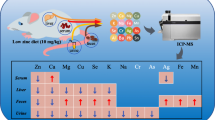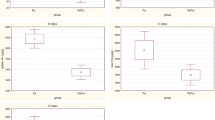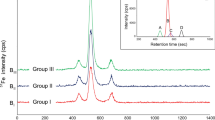Abstract
Tissue distribution of Fe, Mn, Cu, and Zn, the essential trace elements associated with oxidant and/or antioxidant processes, was examined in iodine- and/or selenium-deficient rats (ID, SeD, ISeD). Fe and Mn were the most affected minerals in all types of deficiency states. Mn levels decreased significantly in the liver in all deficiency states (approx 20–30%), in the heart in ID and SeD rats (approx 30–35%) and in the testis in ID rats (approx 15%). Whereas Mn enhancement was noted in kidney (approx 45%) and plasma in SeD and ISeD (approx 20% and 50%, respectively) animals. However, most striking alterations were seen with Fe. Significant elevation of Fe concentrations were observed in all deficiency states in the kidney (approx 90–125%) and heart (approx 20–25%), and in the liver in SeD (approx 35%) and ISeD (approx 75%) rats, whereas significant (approx 20%) Fe enhancement in the testis was observed only in ISeD animals. Lower Cu (approx 10–15%) and higher Zn (approx 10–20%) concentrations in heart tissues in all deficiency states were found; higher Zn (approx 20–35%) in the kidney of SeD and ISeD rats, and lower Cu in the testis of SeD animals were observed. In brain tissue, no alteration was seen in Fe, Mn, and Zn content, however, significantly increased (approx 15–20%) Cu concentrations were noted in all deficiency states. The results of this study indicated that iodine and/or selenium deficiency may modify the distribution and the homeostasis of other minerals.
Similar content being viewed by others
References
P. J. Aggett, Physiology and metabolism of essential trace elements: an outline, Clin. Endocrinol. Metab. 14, 513–543 (1985).
H. Vanucchi, Interaction of vitamins and minerals, Arch. Latinoam. Nutr. 41, 9–18 (1991).
Y. H. Lee, D. K. Layman, R. R. Bell, and H. W. Norton, Response of glutathione peroxidase and catalase to excess dietary iron in rats. J. Nutr. 111, 2195–2202 (1981).
A. G. Abdel Rahim, J. R. Arthur, and C. F. Mills, Effects of dieatary copper, cadmium, iron, molybdenum and manganese on selenium utilization by the rat, J. Nutr. 116, 403–411 (1986).
P. M. Moriarty, M. F. Picciano, J. L. Beard, and C. C. Reddy, Classical selenium-dependent glutathione peroxidase expression is decreased secondary to iron deficiency in rats, J. Nutr. 125, 293–301 (1995).
M. J. Christensen, C. A. Olsen, D. V. Hansen, and B. C. Ballif, Selenium regulates expression in rat liver of genes for proteins involved in iron metabolism, Biol. Trace Element Res. 74, 55–70 (2000).
R. E. Burch, R. V. Williams, H. K. Hahn, M. M. Jetton and J. F. Sullivan, Tissue trace element and enzyme content in pigs fed a low manganese diet. I. A relationship between manganese and selenium, Lab. Clin. Med. 86, 132–139 (1975).
Z. Zhu, M. Kimura, and Y. Itokawa, Mineral status in selenium-deficient rats compared to selenium-sufficient rats fed vitamin-free casein-based or torula yeast-based diet, Biol. Trace Element Res. 37, 219–231 (1993).
K. Matsumoto, T. Inagaki, R. Hirunuma, S. Enomoto, and K. Endo, Contents and uptake rates of Mn, Fe, Co, Zn, and Se in Se-deficient rat liver cell fractions, Anal. Sci. 17, 587–591 (2001).
T. M. Al-Khayat, T. M., Al-Darweesh, and M. S. Islam, The effect of thyroxine, the antithyroid drug propylthiouracil and thyroidectomy on mineral metabolism in rat tissues, J. Clin. Chem. Clin. Biochem. 20, 281–285 (1982).
J. W. Oliver, Effect of thyroid state on magnesium concentration of rat tissues, Am. J. Vet. Res. 39, 159–161 (1978).
K. O. Adeniyi, O. O. Ogunkeye, and C. O. Isichei, Thyroidectomy and thyroxine administration alter serum calcium levels in rat, Acta Physiol. Hung. 81, 95–99 (1993).
D. Behne, A. Kyriakopoulos, H. Meinhold, and J. Kohrle, Identification of type I iodothyronine 5′-deiodinase as a selenoenzyme, Biochem. Biophys. Res. Commun. 173, 1143–1149 (1990).
W. Croteau, S. I. Whittemore, M. Schneider, and D. L. St Germain, Clonning and expression of cDNA for a mammalian type III Iodothyronine deiodinase, J. Biol. Chem. 270, 16569–16575 (1995).
M. J. Berry, L. Banu, and P. R. Larsen, Type I iodothyronine deiodinase is a selenocystein-containing enzyme, Nature 349, 438–440 (1991).
J. R. Arthur and G. J. Beckett, Thyroid function, Br. Med. Bull. 55, 658–668 (1999).
World Health Organization, Trace Elements in Human Nutrition and Health, WHO, Geneva (1996).
V. Ducros and A. Favier, Gas chromatographic-mass spectrometric method for the determination of selenium in biological samples, J. Chromatogr. 583, 35–44 (1992).
G. J. Beckett, F. Nicol, P. W. H. Rae, S. Beech, Y. Guo, and J. R. Arthur, Effects of combined iodine and selenium deficiency on thyroid hormone metabolism in rats, Am. J. Clin. Nutr. 57, 240S-243S (1993).
N. Chareonpong-Kawamoto and K. Yasumoto, Selenium deficiency as a cause of overload of iron and unbalanced distribution of other minerals, Biosci. Biotechnol. Biochem. 59, 302–306 (1995).
N. Chareonpong-Kawamoto, T. Higasa, and K. Yasumoto, Histological study of iron deposits in selenium-deficient rats, Biosci. Biotechnol. Biochem. 59, 1913–1920 (1995).
D. A. Papanastasiou, D. V. Vayenas, A. Vassilopoulos, and M. Repanti, Concentration of iron and distribution of iron and transferrin after experimental iron overload in rat tissues in vivo: study of the liver, the spleen, the central nervous system and other organs, Pathol. Res. Pract. 196, 47–54 (2000).
P. T. Lieu, M. Heiskala, P. A. Peterson, and Y. Yang, The roles of iron in health and disease, Mol. Aspects Med. 22, 1–87 (2001).
X. Qu, K. Huang, L. Deng, and H. Xu, Selenium deficiency-induced alterations in the vascular system of the rat, Biol. Trace Element Res. 75, 119–128 (2000).
S. S. Sobajic, M. B. Mihailovic, and M. O. Miric, The effects of selenium deficiency, dietary selenium, and vitamin E supplementation on the oxidative status of pig liver, J. Environ. Pathol. Toxicol. Oncol. 17, 265–270 (1998).
S. Yetkin, F. Hincal, N. Basaran, and G. Ciliv. Serum selenium status in children with iron deficiency anemia, Acta Haematol. 88, 185–188 (1992).
K. Eder, A. Kralik, and M. Kirchgessner, The effect of manganese supply on thyroid hormone metabolism in the offspring of manganese-depleted dams, Biol. Trace Element Res. 55, 137–145 (1996).
N. Q. Liu, Q. Xu, X. L. Hou, et al., The distribution patterns of trace elements in the brain and erythrocytes in a rat experimental model of iodine deficiency, Brain Res. Bull. 55, 309–312 (2001).
K. Aihara, Y. Nishi, S. Hatano, et al., Zinc, copper, manganese, and selenium metabolism in thyroid disease, Am. J. Clin. Nutr. 40, 26–35 (1984).
A. C. Chua and E. H. Morgan, Effects of iron deficiency and iron overload on manganese uptake and deposition in the brain and other organs of the rat, Biol. Trace Element Res. 55, 39–54 (1996)
E. A. Malecki, A. G. Devenyi, T. F. Barron, T. J. Mosher, P. Eslinger and C. V. Flaherty-Craig, Iron and manganese homeostasis in chronic liver disease: relationship to pallidal T1-weighted magnetic resonance signal hyperintensity, Neurotoxicology 20, 647–652 (1999).
D. V. Vayenas, M. Repanti, A. Vassilopoulos, and D. A. Papanastasiou. Influence of iron overload on manganese, zinc and copper concentration in rat tissues in vivo: study of liver, spleen and brain, Int. J. Clin. Lab. Res. 28, 183–186 (1998).
M. Aschner and J. L. Aschner, Manganese transport across the blood-brain barrier: relationship to iron homeostasis, Brain Res. Bull. 24, 857–860 (1990).
B. Halliwell and J. M. C. Gutteridge, Free Radicals in Biology and Medicine, Clarendon, Oxford (1989).
T. Miyamoto, A. Sakurai, and L. J. DeGroot, Effects of zinc and other divalent metals on deoxyribonucleic acid binding and hormone-binding activity of human alpha 1 thyroid hormone receptor expressed in Escherichia coli, Endocrinology 129, 3027–3033 (1991).
A. Kralik, K. Eder, and M. Kirchgessner, Influence of zinc and selenium deficiency on parameters relating to thyroid hormone metabolism, Horm. Metab. Res. 28, 223–226 (1996).
H. C. Lukaski, C. B. Hall, and M. J. Marchello. Impaired thyroid hormone status and thermoregulation during cold exposure of zinc-deficient rats, Horm. Metab. Res. 24, 363–366 (1992).
M. Ruz, J. Codoceo, J. Galgani, et al., Single and multiple selenium-zinc-iodine deficiencies affect rat thyroid metabolism and ultrastructure, J. Nutr. 129, 174–180 (1999).
K. L. Olin, R. M. Walter, and C. L. Keen, Copper deficiency affects selenoglutathione peroxidase and selenodeiodinase activities and antioxidant defense in weanling rats, Am. J. Clin. Nutr. 59, 654–658 (1994).
Author information
Authors and Affiliations
Rights and permissions
About this article
Cite this article
Giray, B., Riondel, J., Arnaud, J. et al. Iodine and/or selenium deficiency alters tissue distribution pattern of other trace elements in rats. Biol Trace Elem Res 95, 247–258 (2003). https://doi.org/10.1385/BTER:95:3:247
Received:
Accepted:
Issue Date:
DOI: https://doi.org/10.1385/BTER:95:3:247




